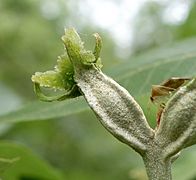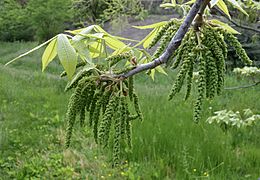Nutmeg hickory facts for kids
Quick facts for kids Nutmeg hickory |
|
|---|---|
| Conservation status | |
| Scientific classification | |
| Genus: |
Carya
|
| Species: |
myristiciformis
|
 |
|
| Natural range of Carya myristiciformis | |
The nutmeg hickory (Carya myristiciformis) is a special tree in the Juglandaceae family, also known as the walnut family. People sometimes call it the swamp hickory or bitter water hickory. You can find this tree in small groups across the Southern United States and in northern Mexico. It likes rich, moist soil near rivers and streams.
The nuts of the nutmeg hickory are full of oil. This makes them a great food source for many wild animals.
Contents
Where Nutmeg Hickory Trees Live
Native Home of the Nutmeg Hickory
The nutmeg hickory is a very rare type of tree. It grows in only a few places. These spots are in southeastern North Carolina, eastern South Carolina, central Alabama and Mississippi, northern Louisiana, southern Arkansas, eastern Texas, and northeastern Mexico.
This tree usually grows in river bottoms. It prefers soil that has lots of calcium or marl ridges. It is only common near Selma, Alabama, and in southern Arkansas. The nutmeg hickory's natural home is almost the same as another rare tree, the Durand Oak. Both might be leftover plants from a much older time.
Climate Nutmeg Hickory Prefers
The areas where nutmeg hickory grows get a lot of rain. They receive between 1020 to 1400 millimeters (40 to 55 inches) of rain each year. More than 510 millimeters (20 inches) of this rain falls during the growing season.
Most of these areas have about 240 days without frost. Summers are warm and dry in the western parts of its range. But they are warm and wet in South Carolina. In July, the average temperature is about 27°C (80°F). In January, it averages between 7° and 10°C (45° and 50°F). Temperatures can go from -23°C (-10°F) to 43°C (110°F).
Soils and Land for Nutmeg Hickory
Nutmeg hickory grows in different kinds of soil. These soils can be loamy, silty, or clayey. They need to be moist but also drain water well. They also need to have plenty of minerals.
You will often find this tree in small stream bottoms. It also grows on flat areas near rivers and on slopes or bluffs close to streams.
Other Trees Growing with Nutmeg Hickory
Nutmeg hickory is not a main tree in any forest type. It is a minor tree in forests with Swamp Chestnut Oak and Cherrybark Oak.
Other trees often found with nutmeg hickory include:
- White ash
- Other hickory types like shagbark hickory, shellbark hickory, mockernut hickory, and bitternut hickory
- Shumard oak
- Blackgum
- Willow oak
- Water oak
- Durand oaks
- American elm and winged elms
- Yellow-poplar
- American beech
Smaller trees and shrubs that grow with it are:
- Eastern hophornbeam
- American hornbeam
- Flowering dogwood
- Oakleaf hydrangea
Near Charleston, South Carolina, people found red buckeye, Eastern redbud, and witch-hazel growing with nutmeg hickory. This tree is often found near old Native American campsites. This is especially true along the Alabama River near Selma. Here, nutmeg hickory grows with other hickory types in mixed hardwood groves.
Nutmeg Hickory Life Cycle
Reproduction and Early Growth
The nutmeg hickory tree has both male and female flowers on the same tree. This is called being monoecious. Both types of flowers grow on the new branches of the year.
- Male flowers are long, hanging clusters called catkins. They grow at the base of the new shoots.
- Female flowers are short spikes. They grow at the end of the new shoots.
The trees flower from April to May, right after their leaves start to open. We don't know much about how their pollen spreads. The nuts are sweet and good to eat. They ripen from September to October and fall from September to December. The nut's shell is thick and hard.
Nutmeg hickory trees start making seeds when they are about 30 years old. They produce the most seeds between 50 and 125 years old. Good seed crops happen every 2 to 3 years. One tree growing in the open can produce as much as 70 liters (2 bushels) of nuts. Animals like squirrels and water help spread the seeds.
The seeds sprout from late April to early June. When they sprout, the seed stays underground. Squirrels burying the seeds seems to be important. But it's not always needed for new seedlings to grow.
We don't have much information on how nutmeg hickory reproduces from its roots or stumps. Like other hickory trees, it probably sprouts easily from small stumps or injured young trees. It can also sprout from its roots. Large stumps usually don't sprout easily.
From Young Tree to Mature Tree
Nutmeg hickory is a medium-sized tree. It has a tall, straight trunk. Its branches spread out a bit, forming a narrow and open top. It can grow to be 24 to 30 meters (80 to 100 feet) tall. Its trunk can be as wide as 61 centimeters (24 inches).
The pecan hickories, which include nutmeg hickory, grow faster than other true hickories. However, they grow slower than most other trees found in river bottoms.
Nutmeg hickory trees probably don't grow in pure groups by themselves. So, we don't have exact numbers for how much wood they produce. When nutmeg hickory wood is cut, it is usually mixed and sold with other hickory woods.
The nutmeg hickory has a strong main root that goes deep into the ground. This is especially true in soil that drains well. Young hickory trees quickly grow a strong main root and many small side roots. As the tree gets older, it develops a strong, spreading root system.
Nutmeg hickory does not like a lot of shade. Adult trees don't do well in shade. But young seedlings and saplings can survive in the shade for a long time. They will then grow quickly if they get more sunlight. If bigger, faster-growing trees are cut down, it helps nutmeg hickory grow.
Fires can harm hickory trees of all ages. A small fire can kill the tops of young trees. A bigger fire can wound larger trees. These wounds can let in fungi that cause the wood to rot.
Several insects attack hickory trees, but they rarely cause big problems.
- The forest tent caterpillar, walnut caterpillar, and walkingstick might eat the leaves of a tree or its branches.
- Sucking insects like aphids feed under the leaves. This makes the leaves curl up and fall off early.
- The twig girdler can seriously trim young trees and even large ones by chewing around the branches.
- The hickory bark beetle can be a problem during dry years or when trees are stressed.
Other beetles, like the ambrosia beetle and powderpost beetles, can damage logs and lumber. This happens while the wood is stored or drying.
There are no major diseases for hickory trees, except for some wood rots. A problem called "bird peck defect" is common and serious in nutmeg hickory. This is caused by the yellow-bellied sapsucker bird.
Special Uses of Nutmeg Hickory
Squirrels love the nuts of the nutmeg hickory. They start eating them even when they are still green. Other small animals and wildlife also eat these nuts.
This tree is too rare in most places to be very important for money. The wood from this type of hickory is a little weaker than other hickory woods. But because there isn't much of it, and it's hard to tell apart from other hickories, it's usually mixed in with other hickory wood when cut.
Genetics of Nutmeg Hickory
Nutmeg hickory trees have 32 chromosomes. They can easily mix with other hickory species. One scientist even mixed it with pecan trees. This tree has some features of both main groups of hickory trees. For example, it has thin husks like one group, but its leaves and buds are like another group.
Gallery







